For the 2025 school year, there are 2 public preschools serving 274 students in Taylor School District. This district's average pre testing ranking is 10/10, which is in the top 5% of public pre schools in Florida.
Public Preschools in Taylor School District have an average math proficiency score of 85% (versus the Florida public pre school average of 57%), and reading proficiency score of 85% (versus the 54% statewide average).
Minority enrollment is 24% of the student body (majority Black), which is less than the Florida public preschool average of 65% (majority Hispanic).
Overview
This School District
This State (FL)
# Schools
9 Schools
1,902 Schools
# Students
2,755 Students
1,124,074 Students
# Teachers
137 Teachers
71,061 Teachers
Student : Teacher Ratio
20:1
20:1
District Rank
Taylor School District, which is ranked within the bottom 50% of all 73 school districts in Florida (based off of combined math and reading proficiency testing data) for the 2021-2022 school year.
The school district's graduation rate of 85-89% has increased from 70-74% over five school years.
Overall District Rank
#58 out of 73 school districts
(Bottom 50%)
(Bottom 50%)
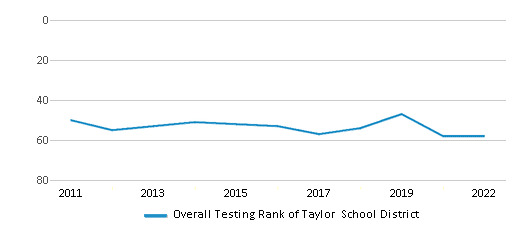
Math Test Scores (% Proficient)
47%
52%
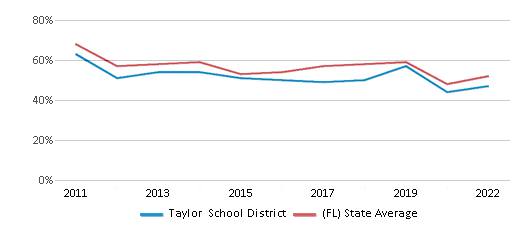
Reading/Language Arts Test Scores (% Proficient)
41%
52%
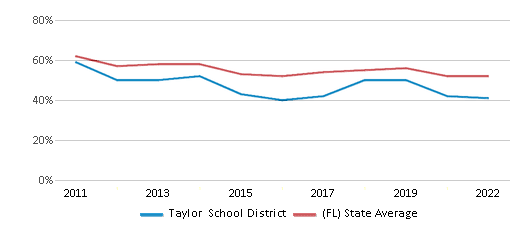
Science Test Scores (% Proficient)
39%
52%
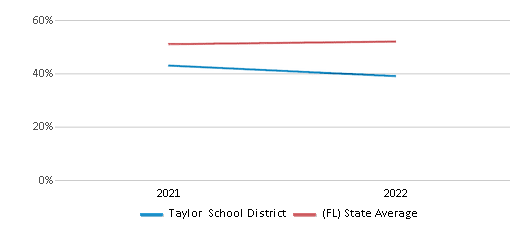
Graduation Rate
85-89%
87%
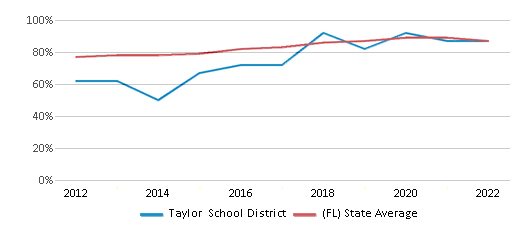
Students by Ethnicity:
Diversity Score
0.53
0.71
# American Indian Students
7 Students
2,515 Students
% American Indian Students
n/a
n/a
# Asian Students
19 Students
28,808 Students
% Asian Students
1%
3%
# Hispanic Students
92 Students
409,820 Students
% Hispanic Students
3%
36%
# Black Students
695 Students
236,066 Students
% Black Students
25%
21%
# White Students
1,753 Students
392,557 Students
% White Students
64%
35%
# Hawaiian Students
5 Students
1,696 Students
% Hawaiian Students
n/a
n/a
# Two or more races Students
184 Students
52,612 Students
% of Two or more races Students
7%
5%
Students by Grade:
# Students in PK Grade:
172
64,349
# Students in K Grade:
231
154,392
# Students in 1st Grade:
212
161,963
# Students in 2nd Grade:
246
167,396
# Students in 3rd Grade:
231
171,016
# Students in 4th Grade:
177
167,752
# Students in 5th Grade:
192
159,415
# Students in 6th Grade:
179
27,337
# Students in 7th Grade:
215
19,963
# Students in 8th Grade:
224
19,106
# Students in 9th Grade:
221
2,380
# Students in 10th Grade:
183
2,273
# Students in 11th Grade:
151
2,437
# Students in 12th Grade:
121
4,295
# Ungraded Students:
-
-
District Revenue and Spending
The revenue/student of $12,328 is higher than the state median of $11,962. The school district revenue/student has stayed relatively flat over four school years.
The school district's spending/student of $13,084 is higher than the state median of $11,615. The school district spending/student has stayed relatively flat over four school years.
Total Revenue
$34 MM
$34,349 MM
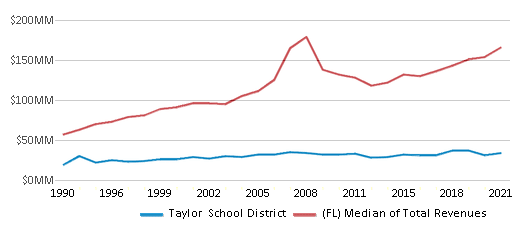
Spending
$36 MM
$33,354 MM
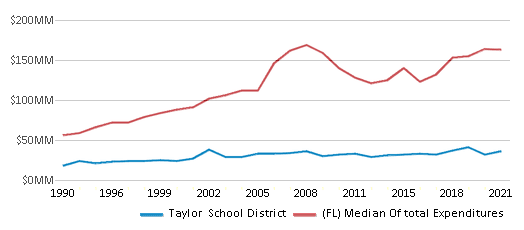
Revenue / Student
$12,328
$11,962

Spending / Student
$13,084
$11,615
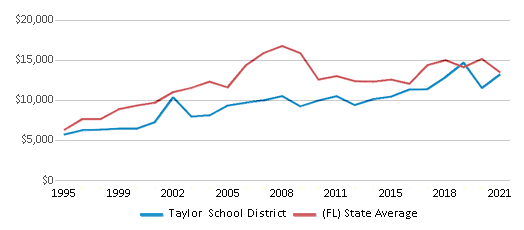
Best Taylor School District Public Preschools (2025)
School
(Math and Reading Proficiency)
(Math and Reading Proficiency)
Location
Grades
Students
Rank: #11.
Steinhatchee School
(Math: 80-89% | Reading: 80-89%)
Rank:
Rank:
10/
Top 5%10
1209 Se 1st Ave
Steinhatchee, FL 32359
(352) 498-3304
Steinhatchee, FL 32359
(352) 498-3304
Grades: PK-5
| 122 students
Recent Articles

Year-Round Or Traditional Schedule?
Which is more appropriate for your child? A year-round attendance schedule or traditional schedule? We look at the pros and cons.

Why You Should Encourage Your Child to Join a Sports Team
Participating in team sports has a great many benefits for children, there is no doubt. In this article you will learn what those benefits are.

White Students are Now the Minority in U.S. Public Schools
Increasing birth rates among immigrant families from Asia and Central and South America, combined with lower birth rates among white families, means that for the first time in history, public school students in the United States are majority-minority. This shift in demographics poses difficulties for schools as they work to accommodate children of varying language abilities and socio-economic backgrounds.





